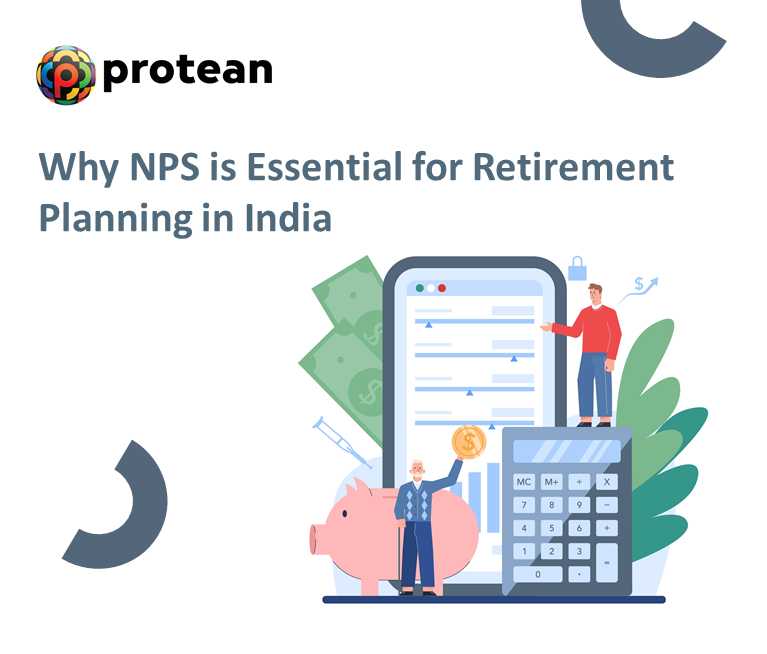For most people in India, retirement saving means EPF, PPF, or fixed deposits. While these are good starting points, the National Pension System (NPS) is quickly becoming a top contender – offering more benefits for your retirement fund than you might expect. This government-regulated scheme (under PFRDA) brings together flexibility, low charges, the chance for market-driven growth, and excellent tax advantages. These features make NPS an incredibly important way to build a large savings pool for your future. Let's see exactly why NPS scheme is becoming a core part of smart retirement planning in India.
The Advantage of Unmatched Tax Benefits
One of the biggest superpowers of the NPS scheme for your retirement planning? Its incredible tax benefits! It offers benefits at three stages – contribution, growth, and withdrawal.
Contribution Stage (Section 80CCD)
- Section 80CCD (1): Your own contributions to the NPS scheme are eligible for a deduction up to ₹1.5 lakh within the overall limit of Section 80C.
- Section 80CCD(1B): This is a unique additional deduction of up to ₹50,000 for your voluntary contributions to NPS, over and above the Section 80C limit. This effectively allows you to claim a total deduction of up to ₹2 lakh on your own contributions in a financial year.
- Section 80CCD (2): If you are a salaried employee, your employer's contribution to your NPS scheme (up to 10% of your Basic Salary + Dearness Allowance, or 14% for Central Government employees) is also deductible, without any monetary limit. This is a powerful benefit that many often overlook.
Growth Stage
The returns generated by your NPS scheme investments are tax-exempt until withdrawal, allowing your corpus to grow untouched by annual taxes. This power of compounding is amplified significantly over the long term.
Withdrawal Stage
- Lump Sum Withdrawal: Upon retirement (age 60), you can withdraw up to 60% of your accumulated corpus as a lump sum, which is entirely tax-exempt.
- Annuity Purchase: The remaining 40% (at least) must be used to purchase an annuity from an Annuity Service Provider (ASP). The income received from this annuity is taxable as per your income tax slab in the year of receipt. This ensures a regular income stream post-retirement.
This tax benefit structure provides a significant advantage over many other retirement instruments, making your savings work harder for you.
| Also Read: Why NPS Tops the List for Retirement Planning |
Maximizing Your Corpus with Transparency
Compared to many other long-term investment and pension products globally, the NPS scheme is remarkably low-cost. The fund management charges and administrative fees are minimal, ensuring that a larger portion of your contributions goes directly into your investments, amplifying the power of compounding over decades.
Furthermore, the NPS scheme operates with high transparency. Subscribers can access their account statements online 24/7, monitor their investments, and track their fund performance, fostering trust and informed decision-making. The scheme is regulated by the PFRDA, a statutory body under the Ministry of Finance, Government of India, adding another layer of security and reliability.
Potential for Higher Growth
Unlike traditional fixed-income pension plans, the NPS scheme invests in market-linked instruments. This exposure to different asset classes offers the potential for inflation-beating returns, especially over the long investment horizon that retirement planning demands. While returns are not guaranteed (as they are market-linked), historical performance has shown the potential for competitive growth compared to many conventional retirement savings options.
| Also Read: Can NRIs Invest in the National Pension System? |
Designed for Long-Term Vision
The structure of the NPS scheme inherently promotes disciplined, long-term saving, which is crucial for effective retirement planning. The long lock-in period until age 60 (with limited partial withdrawals for specific needs like higher education, marriage, or medical emergencies) discourages premature withdrawals in NPS Tier 1 Account, helping you build a substantial retirement corpus. This built-in discipline safeguards your retirement nest egg from short-term financial temptations.
NPS - The Backbone of Your Retirement
In today's fast-changing India, just sticking to old ways of saving might not be enough for a truly comfortable retirement. That's where the NPS scheme shines! It's a strong, flexible, and affordable option that helps you save for the long run, plus it comes with great tax benefits. By putting your money into NPS, using its tax advantages, and choosing your investments wisely, you can set yourself up for financial freedom and enjoy your retirement years stress-free.
FAQs on NPS and Retirement Planning
Q1: What is the minimum and maximum age to open an NPS account?
Any Indian citizen, resident or non-resident, aged between 18 and 70 years can open an NPS scheme account.
Q2: Are contributions to NPS scheme mandatory every year?
No, it's not compulsory to contribute to your NPS scheme Tier I account every single year without fail. However, to ensure your account remains 'active' and accessible for contributions and transactions, a minimum annual contribution of ₹1,000 is required. If this is not made, the account will be frozen until the required minimum is deposited to reactivate it
Q3: What happens to my NPS corpus when I turn 60?
Upon turning 60, NPS offers flexible withdrawal options to meet your retirement needs:
- You can take up to 60% of your accumulated corpus as a tax-free lump sum.
- The remaining portion (minimum 40%) must be used to purchase an annuity from a PFRDA-empanelled provider, guaranteeing you a regular pension income.
- If your total corpus is ₹5 lakh or less, you have the option to withdraw the entire 100% as a tax-exempt lump sum.
- You also have the flexibility to defer both your lump sum withdrawal and/or annuity purchase until age 75, allowing your funds to continue growing within NPS. However, you cannot make additional contributions after 60, only allow the fund to accumulate.

